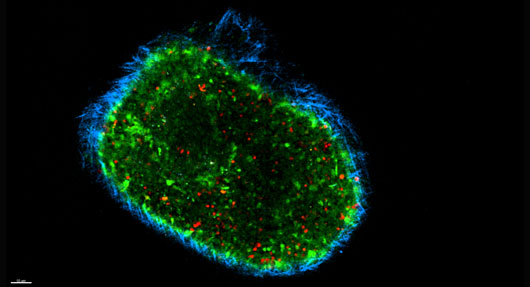Metastatic cancer, in which cancer has spread to other sites beyond the primary tumor, is responsible for almost all cancer deaths, and treatment options remain very limited. New immune therapies that help the body’s own immune cells to attack cancer cells within tumors are showing promise in metastatic cancer – yet little is understood about how these therapies function. T cells and other immune cells accumulate inside tumors – but until now we’ve known very little about what happens next. How does the environment within the tumor change the cells? Do they leave the tumor? Which types of immune cells leave? Where do they go, and why? Answers to these questions may have important implications for our understanding of how our immune system can fight cancer.

Figure: Tumor-egressing immune cells accumulate in draining lymph nodes. A two-photon microscopy image of a tumor-draining lymph node showing tumor-egressing cells (red), total cells (green) and 2nd harmonic/collagen (blue).
In our recent study we observed for the first time that ‘tumor-trained’ immune cells – which have the potential to kill cancer cells – can move from one tumor to another. To watch ‘tumor-trained’ immune cells travelling through the body, we used an innovative ‘photoconversion’ strategy – in which all the cells in a mouse are labeled with a green fluorescent compound, and only those within a tumor (including immune cells) are turned to red by shining a bright light on the tumor. We observed immune cells leaving the tumor and moving into lymph nodes – and, importantly, we could see immune cells moving out of one tumor and into another, distant tumor. The mix of immune cells leaving tumors was sharply different to the mix of immune cells going in. Unexpectedly, T cells were the main immune cells to exit tumors and move to lymph nodes and other tumors – even though they represent only a fraction of the immune cells that enter tumors. Some classes of T cell, such as CD8+ effector T cells, which promote tumor destruction, were more likely to exit the tumor suggesting strong control over the tumor-exiting process. Importantly, the T cells that had been exposed to the tumor’s ‘microenvironment’ and then exited the tumor were more activated, and had a stronger cytotoxic (cell-killing) activity, than those that did not enter the tumor. This suggests that, within the tumor, these T cells are acquiring knowledge about the cancer that helps them to seek and destroy tumor cells. The new findings shed light on how immune therapies for cancer might work, and suggest new approaches to developing anti-cancer immune therapies. Ultimately, we’re working to understand more deeply the relationships between immune and cancer cells, so that we can design approaches to empower the immune system to destroy cancer.
Reference
In vivo photolabeling of tumor-infiltrating cells reveals highly regulated egress of T-cell subsets from tumors. Tommaso Torcellan, Henry R. Hampton, Jacqueline Bailey, Michio Tomura, Robert Brink, and Tatyana Chtanova. PNAS 2017 114 (22) 5677-5682; published ahead of print May 15, 2017, doi:10.1073/pnas.1618446114.


































